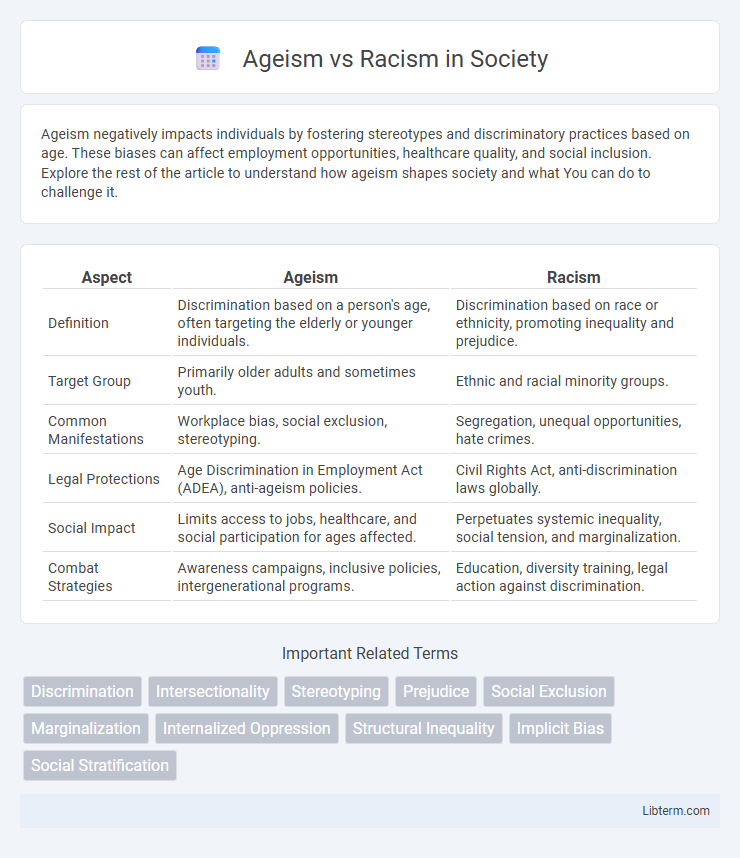Ageism negatively impacts individuals by fostering stereotypes and discriminatory practices based on age. These biases can affect employment opportunities, healthcare quality, and social inclusion. Explore the rest of the article to understand how ageism shapes society and what You can do to challenge it.
Table of Comparison
| Aspect | Ageism | Racism |
|---|---|---|
| Definition | Discrimination based on a person's age, often targeting the elderly or younger individuals. | Discrimination based on race or ethnicity, promoting inequality and prejudice. |
| Target Group | Primarily older adults and sometimes youth. | Ethnic and racial minority groups. |
| Common Manifestations | Workplace bias, social exclusion, stereotyping. | Segregation, unequal opportunities, hate crimes. |
| Legal Protections | Age Discrimination in Employment Act (ADEA), anti-ageism policies. | Civil Rights Act, anti-discrimination laws globally. |
| Social Impact | Limits access to jobs, healthcare, and social participation for ages affected. | Perpetuates systemic inequality, social tension, and marginalization. |
| Combat Strategies | Awareness campaigns, inclusive policies, intergenerational programs. | Education, diversity training, legal action against discrimination. |
Understanding Ageism and Racism: Key Definitions
Ageism refers to discrimination or prejudice against individuals based on their age, often targeting older adults, while racism involves bias or systemic oppression directed at people due to their race or ethnicity. Both ageism and racism manifest through stereotypes, social exclusion, and unequal access to resources, impacting mental health, employment, and social interactions. Understanding these key definitions highlights the importance of addressing structural inequalities and promoting inclusive policies across age and racial groups.
Historical Roots of Ageism and Racism
The historical roots of ageism trace back to ancient civilizations where youth was often equated with strength and productivity, while older adults were marginalized or considered less valuable. Racism stems from colonialism and slavery, where racial hierarchies were constructed to justify exploitation and segregation based on perceived biological differences. Both ageism and racism evolved through systemic social, economic, and political structures that perpetuated discrimination and unequal treatment across generations.
Social Impacts: How Ageism and Racism Shape Societies
Ageism and racism deeply influence societal structures by perpetuating inequality and limiting access to resources for marginalized groups. Both forms of discrimination contribute to social exclusion, reduced economic opportunities, and disparities in healthcare and education. The compounded effects of ageism and racism hinder social cohesion and impede the development of inclusive communities.
Stereotypes and Prejudices: Differences and Similarities
Ageism and racism both involve stereotypes and prejudices that unfairly categorize individuals based on age or race, leading to discrimination in social, professional, and institutional contexts. Ageist stereotypes often portray older adults as frail or resistant to change, while racial stereotypes assign fixed traits or abilities based on ethnic background, perpetuating systemic inequality. Both forms of prejudice reinforce exclusion and inequality, but ageism is unique in its potential for everyone to experience it over time, unlike racism, which is closely tied to ethnic identity and historical oppression.
Institutional Ageism vs. Structural Racism
Institutional ageism manifests through policies and practices within organizations that systematically disadvantage older individuals, such as mandatory retirement ages and exclusion from hiring processes. Structural racism operates on a broader societal level, embedding racial inequalities in economic, educational, and legal systems that disproportionately affect marginalized racial groups. Both phenomena perpetuate discrimination, but institutional ageism is localized within specific entities, whereas structural racism is deeply ingrained across interconnected societal frameworks.
Health and Economic Consequences
Ageism and racism both contribute to significant health disparities and economic inequalities, disproportionately affecting marginalized groups. Ageism leads to reduced access to healthcare, social isolation, and increased chronic disease among older adults, while racism causes higher rates of stress-related illnesses, limited healthcare resources, and economic disadvantages for racial minorities. These intersecting forms of discrimination result in compounded negative outcomes, including higher mortality rates and reduced economic mobility.
Media Representation: Age and Race in the Spotlight
Media representation often reinforces stereotypes linked to both ageism and racism, shaping public perceptions and social attitudes. Older adults are frequently portrayed as frail or out of touch, while racial minorities are stereotyped in limiting roles, perpetuating systemic biases. Balanced, diverse portrayals in media can challenge these prejudices by highlighting the complexity and vitality of different age groups and racial backgrounds.
Intersectionality: When Ageism and Racism Overlap
Ageism and racism intersect to create compounded discrimination affecting individuals who belong to both marginalized age and racial groups, intensifying social exclusion and bias. Intersectionality reveals how older adults from racial minorities face unique challenges in healthcare, employment, and social services due to overlapping prejudices. Understanding this overlap is crucial for developing inclusive policies that address the multifaceted nature of discrimination and promote equity for all populations.
Combating Discrimination: Advocacy and Solutions
Combating discrimination requires targeted advocacy that addresses the unique challenges of both ageism and racism through inclusive policies and education. Organizations promote awareness campaigns and legal reforms to dismantle systemic biases, ensuring equitable treatment across all age groups and racial communities. Implementing intersectional strategies enhances social cohesion and fosters environments where diversity is respected and protected.
Towards Inclusivity: Building Age- and Race-Equitable Communities
Building age- and race-equitable communities requires addressing both ageism and racism through inclusive policies that recognize the intersecting identities of individuals. Effective strategies involve equitable access to resources, representation in decision-making, and creating safe environments that honor diverse experiences across all ages and races. Promoting intergenerational and multicultural dialogues fosters understanding and dismantles systemic barriers, paving the way for truly inclusive societies.
Ageism Infographic

 libterm.com
libterm.com